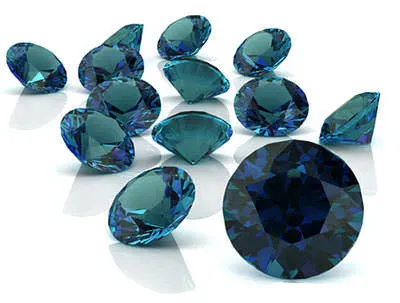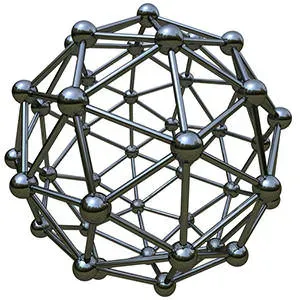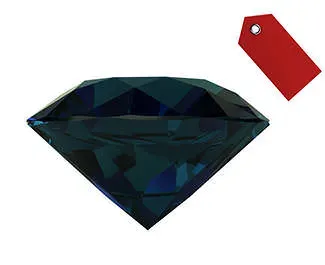 Alexandrite is the birthstone for June (along with the pearl) and the Anniversary stone for the 55th year of marriage. It is also considered Friday's stone, or the stone of "Friday's Child." It is an extremely rare gemstone and a reasonably modern one to boot. It does not share the ancient history and lore of most other gems because it was first discovered in the 19th Century. The name Alexandrite comes from the fact that the gemstone was first found in the
Alexandrite is the birthstone for June (along with the pearl) and the Anniversary stone for the 55th year of marriage. It is also considered Friday's stone, or the stone of "Friday's Child." It is an extremely rare gemstone and a reasonably modern one to boot. It does not share the ancient history and lore of most other gems because it was first discovered in the 19th Century. The name Alexandrite comes from the fact that the gemstone was first found in the ![]() emerald mines near the Tokovaya River in Russia's Ural Mountains in 1830, on the day of Prince Alexander II of Russia's birthday. The story of the stone's discovery goes like this: Miners were working alone in the mountains one day, collecting emeralds. One miner gathered some stones, which looked like emeralds, and took them back to the camp at the end of the day. But in the campfire's light, the stones shone a brilliant shade of red! The miners were perplexed. When morning came, and they saw that the stones were green again in the light, they realized they had found a new and mysterious gem.
emerald mines near the Tokovaya River in Russia's Ural Mountains in 1830, on the day of Prince Alexander II of Russia's birthday. The story of the stone's discovery goes like this: Miners were working alone in the mountains one day, collecting emeralds. One miner gathered some stones, which looked like emeralds, and took them back to the camp at the end of the day. But in the campfire's light, the stones shone a brilliant shade of red! The miners were perplexed. When morning came, and they saw that the stones were green again in the light, they realized they had found a new and mysterious gem.
 In 1839, the stones were identified and named "alexandrites." Because they appeared green or red, the same colors as Old Imperial Russia's military colors, the gem became the national stone of Tsarist Russia. Alexandrite would become one of the most prized gemstones in Russian Aristocracy. However, the abundance of alexandrites in Russia did not last forever. Practically all of Russia's alexandrite was mined during the 19th Century. However, just when the gems were thought to be headed to extinction, even more significant deposits were found in Ceylon, now Sri Lanka, the island south of India. Later, Brazil became another contributor to the world's gemstone supply.
In 1839, the stones were identified and named "alexandrites." Because they appeared green or red, the same colors as Old Imperial Russia's military colors, the gem became the national stone of Tsarist Russia. Alexandrite would become one of the most prized gemstones in Russian Aristocracy. However, the abundance of alexandrites in Russia did not last forever. Practically all of Russia's alexandrite was mined during the 19th Century. However, just when the gems were thought to be headed to extinction, even more significant deposits were found in Ceylon, now Sri Lanka, the island south of India. Later, Brazil became another contributor to the world's gemstone supply.
 While Alexandrites found favor in the jewelry salons of St. Petersburg, Russia, and Paris, France, America's Tiffany Company has done the most to popularize the gem. George Kunz, Tiffany's master gem buyer, fell absolutely in love with the stone and traveled to Russia in search of it. No one knows precisely how much of the gemstone he bought, but Tiffany had large reserves that cornered the market on the stone for decades. There were no new mineral discoveries for much of the 20th Century, so it became scarce. 1987, a new find was made at Minas Gerais, Brazil. In 1993, another significant find was discovered on the border of Tanzania and Mozambique.
While Alexandrites found favor in the jewelry salons of St. Petersburg, Russia, and Paris, France, America's Tiffany Company has done the most to popularize the gem. George Kunz, Tiffany's master gem buyer, fell absolutely in love with the stone and traveled to Russia in search of it. No one knows precisely how much of the gemstone he bought, but Tiffany had large reserves that cornered the market on the stone for decades. There were no new mineral discoveries for much of the 20th Century, so it became scarce. 1987, a new find was made at Minas Gerais, Brazil. In 1993, another significant find was discovered on the border of Tanzania and Mozambique.
 Since the discovery of alexandrite, the gemstone has been thought to bring luck, good fortune, and love. In Russia, it is considered a stone of excellent omen. It is believed to bring balance between the physical and spiritual or astral worlds. It opens the crown chakra, bringing one access to the universe's warm, healing energy and love. It is also said to strengthen intuition, creativity, and imagination.
Since the discovery of alexandrite, the gemstone has been thought to bring luck, good fortune, and love. In Russia, it is considered a stone of excellent omen. It is believed to bring balance between the physical and spiritual or astral worlds. It opens the crown chakra, bringing one access to the universe's warm, healing energy and love. It is also said to strengthen intuition, creativity, and imagination.
 Alexandrite encourages romance. It is also said that through the stone, joy enters the lives of people with too much self-discipline. The stone reminds us of our purpose in life and our origin. It gives hope to those who are in despair about their lives. It brings strength and constantly reminds them of the light. With its changing color, it is a reminder that life is not only what it seems to be.
Alexandrite encourages romance. It is also said that through the stone, joy enters the lives of people with too much self-discipline. The stone reminds us of our purpose in life and our origin. It gives hope to those who are in despair about their lives. It brings strength and constantly reminds them of the light. With its changing color, it is a reminder that life is not only what it seems to be.
 There are many ways alexandrites are said to aid in physical illness. They are recommended for those recovering from surgery or a prolonged illness. They can help the system in restoring internal and physical energy. They may also be of value to those who face chronic disorders. Contemporary crystal healing practitioners claim the gemstone helps treat problems of the spleen and pancreas, regenerate nerves, and treat Leukemia.
There are many ways alexandrites are said to aid in physical illness. They are recommended for those recovering from surgery or a prolonged illness. They can help the system in restoring internal and physical energy. They may also be of value to those who face chronic disorders. Contemporary crystal healing practitioners claim the gemstone helps treat problems of the spleen and pancreas, regenerate nerves, and treat Leukemia.
Alexandrites are also useful for one's emotional well being, as well as promoting self-esteem and the ability to be appreciative of the world around us. The stone assists one in developing "inner energy changes" which correspond with age and maturation. Alexandrites can aid in centering oneself. Metaphysicians say alexandrite crystals may be used to help one return to the origin of time and to connect with the beginning of one's development.
 Alexandrite is a variety of the mineral chrysoberyl. What makes Alexandrite different from other varieties of the mineral, such as a cat's eye, is the presence of not only iron and titanium, but also chromium as a major impurity. This combination of elements results in the green color of the gemstone. Alexandrite can be almost
Alexandrite is a variety of the mineral chrysoberyl. What makes Alexandrite different from other varieties of the mineral, such as a cat's eye, is the presence of not only iron and titanium, but also chromium as a major impurity. This combination of elements results in the green color of the gemstone. Alexandrite can be almost ![]() emerald colored, but is more often yellowish green or brownish green. The most prized shades of green of an alexandrite can be described as "emerald, grass, splendid or elegant" and the red shade may be described as "
emerald colored, but is more often yellowish green or brownish green. The most prized shades of green of an alexandrite can be described as "emerald, grass, splendid or elegant" and the red shade may be described as "![]() ruby, columbine,
ruby, columbine, ![]() garnet, raspberry or fiery". The more opaque the color, the more expensive the stone. Those stones of a more clear variety are described in color as "dull grass, grayish, opaque, olive or elm-leaf", while the red shade may be referred to as "murky, cinnamon, Venetian, dull coral, or brownish".
garnet, raspberry or fiery". The more opaque the color, the more expensive the stone. Those stones of a more clear variety are described in color as "dull grass, grayish, opaque, olive or elm-leaf", while the red shade may be referred to as "murky, cinnamon, Venetian, dull coral, or brownish".
 Alexandrite's main characteristic is the ability to change color if exposed to a light source that is rich in red rays. This metamorphosis is called Pleochroism. Under such light, such as candlelight, or artificial light, the stone turns red or reddish. This pronounced color change is highly prized. The most valuable alexandrites are brilliant green, and change color to a fiery red under light. The most drastic color changes are the most desirable, as if you were watching a traffic light change color. Usually there is a color bleed through from one color to the other, or there is too much impurity to start with to permit such a drastic color change. Alexandrites from Brazil boast 100% color change, and are therefore the most prized. Because of this color change characteristic, the stone has been called "
Alexandrite's main characteristic is the ability to change color if exposed to a light source that is rich in red rays. This metamorphosis is called Pleochroism. Under such light, such as candlelight, or artificial light, the stone turns red or reddish. This pronounced color change is highly prized. The most valuable alexandrites are brilliant green, and change color to a fiery red under light. The most drastic color changes are the most desirable, as if you were watching a traffic light change color. Usually there is a color bleed through from one color to the other, or there is too much impurity to start with to permit such a drastic color change. Alexandrites from Brazil boast 100% color change, and are therefore the most prized. Because of this color change characteristic, the stone has been called "![]() emerald by day,
emerald by day, ![]() ruby by night". Color change such as this also occurs in
ruby by night". Color change such as this also occurs in ![]() sapphire and tourmaline, but alexandrite shows the most dramatic change.
sapphire and tourmaline, but alexandrite shows the most dramatic change.
 Alexandrite is usually found in sizes smaller than five carats. Sizes over five carats are usually considered large and will command a proportionally higher price. In Ceylon, some of the largest Alexandrites in the world are found, some weighing up to 60 carats each. These stones are of a darker color. Alexandrite is a hard, durable stone, rating an 8.5 on the hardness scale. It is exceeded in hardness only by the
Alexandrite is usually found in sizes smaller than five carats. Sizes over five carats are usually considered large and will command a proportionally higher price. In Ceylon, some of the largest Alexandrites in the world are found, some weighing up to 60 carats each. These stones are of a darker color. Alexandrite is a hard, durable stone, rating an 8.5 on the hardness scale. It is exceeded in hardness only by the ![]() diamond and corundum. It is because of this, and because it is one of the world's most rare gems, that the Alexandrite can be one of the costliest gemstones in the world.
diamond and corundum. It is because of this, and because it is one of the world's most rare gems, that the Alexandrite can be one of the costliest gemstones in the world.
 Alexandrites have been found in Russia and in Brazil, though the Brazilian stones do not display as rich a green color as the Russian stones have been known for. They are also found in Sri Lanka, however there as well, the color shades of the stones are not as bright as the Russians. Since the mid 1990's, Southern Tanzania has been producing alexandrite. It has also been found in Zimbabwe, Burma, India, and Madagascar.
Alexandrites have been found in Russia and in Brazil, though the Brazilian stones do not display as rich a green color as the Russian stones have been known for. They are also found in Sri Lanka, however there as well, the color shades of the stones are not as bright as the Russians. Since the mid 1990's, Southern Tanzania has been producing alexandrite. It has also been found in Zimbabwe, Burma, India, and Madagascar.
 Alexandrite is rated "excellent" for everyday wear however one must still use caution and protect it from harsh chemicals, extreme temperatures and scratches. The best way to clean the stone is with mild dish soap and warm water, using a soft toothbrush.
Alexandrite is rated "excellent" for everyday wear however one must still use caution and protect it from harsh chemicals, extreme temperatures and scratches. The best way to clean the stone is with mild dish soap and warm water, using a soft toothbrush.